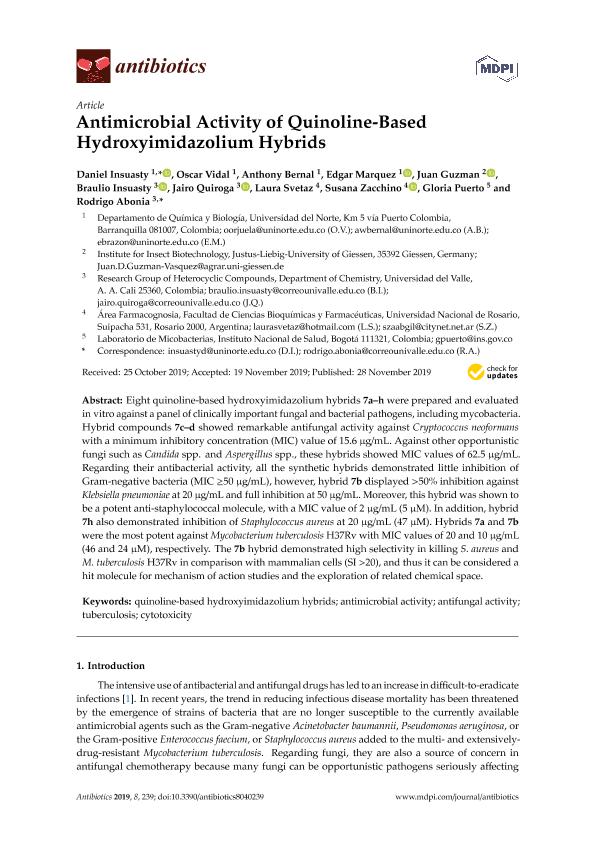Artículo
Antimicrobial Activity of Quinoline-Based Hydroxyimidazolium Hybrids
Insuasty, Daniel; Vidal, Oscar; Bernal, Anthony; Marquez, Edgar; Guzman, Juan; Insuasty, Braulio; Quiroga, Jairo; Svetaz, Laura Andrea ; Zacchino, Susana Alicia Stella; Puerto, Gloria; Abonia, Rodrigo
; Zacchino, Susana Alicia Stella; Puerto, Gloria; Abonia, Rodrigo
 ; Zacchino, Susana Alicia Stella; Puerto, Gloria; Abonia, Rodrigo
; Zacchino, Susana Alicia Stella; Puerto, Gloria; Abonia, Rodrigo
Fecha de publicación:
11/2019
Editorial:
MDPI
Revista:
Antibiotics
ISSN:
2079-6382
e-ISSN:
2079-6382
Idioma:
Inglés
Tipo de recurso:
Artículo publicado
Clasificación temática:
Resumen
Eight quinoline-based hydroxyimidazolium hybrids 7a–h were prepared and evaluated in vitro against a panel of clinically important fungal and bacterial pathogens, including mycobacteria. Hybrid compounds 7c–d showed remarkable antifungal activity against Cryptococcus neoformans with a minimum inhibitory concentration (MIC) value of 15.6 µg/mL. Against other opportunistic fungi such as Candida spp. and Aspergillus spp., these hybrids showed MIC values of 62.5 µg/mL. Regarding their antibacterial activity, all the synthetic hybrids demonstrated little inhibition of Gram-negative bacteria (MIC ≥50 µg/mL), however, hybrid 7b displayed >50% inhibition against Klebsiella pneumoniae at 20 µg/mL and full inhibition at 50 µg/mL. Moreover, this hybrid was shown to be a potent anti-staphylococcal molecule, with a MIC value of 2 µg/mL (5 µM). In addition, hybrid 7h also demonstrated inhibition of Staphylococcus aureus at 20 µg/mL (47 µM). Hybrids 7a and 7b were the most potent against Mycobacterium tuberculosis H37Rv with MIC values of 20 and 10 µg/mL (46 and 24 µM), respectively. The 7b hybrid demonstrated high selectivity in killing S. aureus and M. tuberculosis H37Rv in comparison with mammalian cells (SI >20), and thus it can be considered a hit molecule for mechanism of action studies and the exploration of related chemical space.
Archivos asociados
Licencia
Identificadores
Colecciones
Articulos(CCT - ROSARIO)
Articulos de CTRO.CIENTIFICO TECNOL.CONICET - ROSARIO
Articulos de CTRO.CIENTIFICO TECNOL.CONICET - ROSARIO
Citación
Insuasty, Daniel; Vidal, Oscar; Bernal, Anthony; Marquez, Edgar; Guzman, Juan; et al.; Antimicrobial Activity of Quinoline-Based Hydroxyimidazolium Hybrids; MDPI; Antibiotics; 8; 4; 11-2019; 1-11
Compartir
Altmétricas



